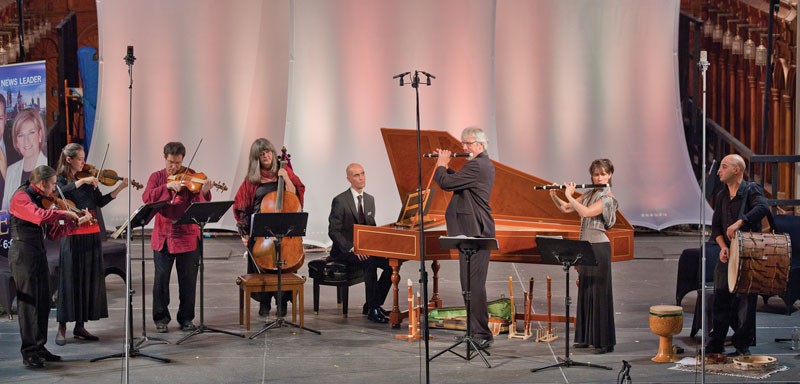Ensemble Caprice rethinks Baroque music for modern times

Courtesy / Matthias Maute Caprice
Feb 20, 2013
Ensemble Caprice specializes in interpreting Baroque music.
Renowned by The New York Times as “a group that encourages listeners to rehear the world,” the Montreal-based Ensemble Caprice will be making their Grand Valley State University debut Feb. 27 as a part of the Arts at Noon series.
“Players put the soul into the music,” said Matthias Maute, one of the group’s artistic directors, who also plays Baroque flute and recorder. “These are pieces that need salt and pepper.”
Gregory Crowell, a GVSU associate professor of music, specializes in Baroque music and is familiar with the group’s work.
“Ensemble Caprice is made up of some of the top performers of this music in the world,” Crowell said. “The recorder player Matthias Maute is considered one of the most exciting and virtuosic performers on the instrument in modern times.”
Crowell said the GVSU performance is a good way for students to be introduced to Baroque culture.
“Students who attend the performance by Ensemble Caprice at GVSU will be delighted by the energy and excitement of their playing, and will sense that this music, which some might describe as old, still has deep cultural relevance today,” Crowell said. “The ensemble will really bring this music to life.”
Their program, “Salsa Baroque,” features compositions that combine European polyphony and Latin American traditional music, which includes pieces by Bolivian composer Juan de Araujou and sonatas by Pietro Locatelli and Andrea Falconieri.
“Many classical players take the score as it is and reconstruct something as close as possible to what it might have been,” Maute said. “With Baroque music, the score serves as the framework. We add our own ornamentation and elaboration.”
Scores dating from the Baroque era of approximately 1600-1750 feature many shorthand notation symbols in the bass line, called “basso continuo.” These symbols provide musicians of chord-playing instruments with the harmonic structure, but do not specifically instruct in chord spacing, voice doubling or part leading.
“It is an artistic decision made on the spot,” Maute said.
As one of the artistic directors, Maute arranges pieces for their performances. In keeping with Baroque instrumentation, he tailors certain scores to include Baroque instruments, such as the recorders and Baroque flutes that play in the ensemble.
“I arrange whatever we need for our instruments,” Maute said. “(The players) add their own ornamentation. We are always finding ways to make the music sound new to ourselves.”
The group released a two-disc CD last September, on which they explore the works of J.S. Bach and Dmitri Shostakovich. Shostakovich, a composer active during the 20th century, wrote a lot of music inspired by Bach, and in recognizing this, Maute arranged several of Shostakovich’s preludes and one fugue to be played by a Baroque orchestra.
“It was an exciting dialogue between two composers who never met each other,” Maute said. “(Shostakovich’s) music perfectly matches the phrasings of (Bach’s) music.”
The concert programs, put together by Maute and artistic director Sophie Larivière depend upon the group’s touring schedule. While the ensemble frequently tours throughout Canada and the U.S., they are also regularly invited to perform in music festivals across Europe.
Next year, they will tour Germany with 22 musicians. Traveling influences a lot of their musical choices for practical reasons.
“You can’t take a harpsichord with you,” Maute said. “The Baroque guitar, for example, travels better.”
While the program accounts for traveling, it also encompasses a representative, artistic idea that features a theme interpreted by the music they perform.
“There is nothing we’re not doing,” Maute said. “We try to cover as much musical field as possible.”
Because of the Baroque scores, every performance by Ensemble Caprice is something new. Maute said that they are constantly faced with a challenge of coming up with creative ideas.
“Something must happen between the beginning and end of the performance that I am a different person at the end,” Maute said. “The audience embarks on that same journey. Music is more than entertainment. It must be a journey with one’s self.”
After their GVSU performance, the ensemble will be performing in Grand Rapids at St. Mark’s Episcopal Church on March 3 at 5 p.m. The concert, “La Follia,” explores the influences of the Romani people, or “Gypsies,” in Baroque music.
“I particularly admire the way Ensemble Caprice delves into the rich cultural influences on this music,” Crowell said. “Influences that give the music another level of expressivity and excitement.”
The GVSU performance is free and begins at noon in the Cook-DeWitt Center. For more information on Ensemble Caprice, go to www.ensemblecaprice.com.





















